Experimental Analysis and Machine Learning of Ground Vibrations Caused by an Elevated High-Speed Railway Based on Random Forest and Bayesian Optimization
Abstract
:1. Introduction
2. Materials and Methods
2.1. Overview
- (1)
- A field experiment was carried out to measure the ground vibrations caused by high-speed trains running on bridge. The layout of measurement points on ground is demonstrated in Figure 1. During the test, a total of 14 sets of valid data were collected, in which the high-speed train traveled at speeds of 200–335 km/h.
- (2)
- Then, the environmental vibration characteristics were analyzed in view of ground accelerations and weighted vibration levels. Some assessments of environmental vibrations were generated from experimental datasets.
- (3)
- Based on the assessments, factors with great effects were selected as input features for the machine learning prediction model, and the initial dataset was generated.
- (4)
- The data set was used to create prediction models with three different machine learning algorithms based on linear regression, support vector machine, and random forest. Those models were compared using 5-fold cross-validation (subgraph lying in top right corner of Figure 1), and the results showed that random forest has the best performance.
- (5)
- Two optimized vibration prediction models were created on the basis of the random forest algorithm, and the random forest hyperparameters were optimized with the mean value of 5-fold cross-validation as the objective function of BO and RS. The performance of the two optimized models was compared.
- (6)
- Results showed that Bayesian optimization has excellent performance and high efficiency in achieving efficient and in-depth optimization of parameters and can be combined with the RF machine learning algorithm to effectively predict the environmental vibrations induced by the high-speed railway, which can be seen in subgraph lying in lower right corner of Figure 1.
2.2. Experimental Analysis of Ground Vibration by Elevated HSR
2.3. Developing of Machine learning Prediction Method
2.4. Hyperparameter Tuning and Optimization Method
3. Results and Discussion
3.1. Characteristics Analysis of Measured Ground Vibrations
3.2. Assessment of Environmental Vibrations Generated from the HSR Bridge
3.3. Determination of the Optimal Machine Learning Algorithm
3.4. Determination of the Optimal Optimization Method
4. Conclusions
- (1)
- The proposed prediction model constructed with the random forest algorithm based on Bayesian optimization is proven to be effective;
- (2)
- The cyclic loading of vehicles can be observed obviously in the time history of ground acceleration when the observation point is close to the center line of the bridge pier. Also, the periodic exciting frequencies produced by the characteristic parameters of the HSR train can be obviously found as the predominant frequencies in the frequency spectra of ground vibrations;
- (3)
- For the ground vibrations generated by the elevated HSR railway, the medium-high frequency component within 30–200 Hz attenuates rapidly with the increase in distance, while the low frequency component within 0–30 Hz attenuates slowly and travels far;
- (4)
- Compared with the linear regression and support vector regression, the random forest algorithm in machine learning has a higher prediction accuracy and is the preferred method in the intellectual prediction of environmental vibration;
- (5)
- The Bayesian optimization has excellent performance and high efficiency in achieving efficient and in-depth optimization of parameters, and can be combined with the RF machine learning algorithm to effectively predict the environmental vibrations induced by a high-speed railway;
- (6)
- The size of the high-speed railway vibration database is an important factor that restricts the effectiveness of machine learning. In this paper, the amount of experimental data is small, and the expanding of database scope from a large number of on-site experiments is the focus in the future research.
Author Contributions
Funding
Institutional Review Board Statement
Informed Consent Statement
Data Availability Statement
Conflicts of Interest
References
- Celebi, E.; Kirtel, O.; Zulfikar, A.C.; Goktepe, F.; Faizan, A.A.; Istegun, B. In-situ measurements and data analysis of environmental vibrations induced by high-speed trains: A case study in North-Western Turkey. Soil Dyn. Earthq. Eng. 2022, 156, 107211. [Google Scholar] [CrossRef]
- Ulgen, D.; Ertugrul, O.L.; Ozkan, M.Y. Measurement of ground borne vibrations for foundation design and vibration isolation of a high-precision instrument. Measurement 2016, 93, 385–396. [Google Scholar] [CrossRef]
- Gregorini, A.; Paganoni, S.; Zappa, E.; Cigada, A.; Canali, F. Effects of environmental vibration on ancient stained-glass windows. J. Cult. Herit. 2022, 56, 65–74. [Google Scholar] [CrossRef]
- Zhang, C.; Zhang, N.; Zhang, Y.S.; Liu, X. Prediction of traffic vibration environment of ancient wooden structures based on the response transfer ratio function. Sensors 2022, 22, 8414. [Google Scholar] [CrossRef]
- Gu, Y.W.; Nie, X.; Yan, A.G.; Zeng, J.H.; Liu, Y.F.; Jiang, Y.X. Experimental and numerical study on vibration and structure-borne noise of high-speed railway composite bridge. Appl. Acoust. 2022, 192, 108757. [Google Scholar] [CrossRef]
- Zhang, Z.; Li, X.; Zhang, X.; Fan, J.; Xu, G. Semi-analytical simulation for ground-borne vibration caused by rail traffic on viaducts: Vibration-isolating effects of multi-layered elastic supports. J. Sound Vib. 2022, 516, 116540. [Google Scholar] [CrossRef]
- Colaço, A.; Castanheira Pinto, A.; Alves Costa, P.; Fernández Ruiz, J. Combination of experimental measurements and numerical modelling for prediction of ground-borne vibrations induced by railway traffic. Constr. Build. Mater. 2022, 343, 127928. [Google Scholar] [CrossRef]
- Yaru, L.; Jing, Z.; Qunsheng, W.; Mao, R. Dynamic performance study of railway vehicle on half-vehicle roller rig. Int. J. Dyn. Control 2023, 11, 473–481. [Google Scholar]
- Anni, Z.; Jingwen, H.; Jianqiao, S. Estimation of wheel–rail structural interactions from motion signals of high-speed train bogie. Int. J. Dyn. Control 2023, 11, 1609–1620. [Google Scholar]
- Lang, J. Results of measurements on the control of structure-borne noise from subways. In Proceedings of the 7th International Congress on Acoustics, Budapest, Hungary, 18–26 August 1971. [Google Scholar]
- ISO 14837-1; Mechanical Vibration: Ground-Borne Noise and Vibration Arising from Rail Systems—Part 1: General Guidance. International Organization for Standardization: Geneva, Switzerland, 2005.
- Yulong, H.; Qing, Z.; Lizhong, Y. Environmental vibration test and analysis of viaduct bridge of 350 km/h high-speed railway. Noise Vib. Control 2012, 32, 170–173. [Google Scholar]
- Connolly, D.P.; Costa, P.A.; Kouroussis, G.; Galvin, P.; Woodward, P.K.; Laghroughe, O. Large scale international testing of railway ground vibrations across Europe. Soil Dyn. Earthq. Eng. 2015, 71, 1–12. [Google Scholar] [CrossRef]
- Auersch, L. Simple and fast prediction of train-induced track forces, ground and building vibrations. Railw. Eng. Sci. 2020, 28, 232–250. [Google Scholar] [CrossRef]
- Li, X.; Cao, G.; Zu, Y. Tests for vibration transmission characteristics of a high-speed railway track-bridge-soil system. J. Vib. Shock 2019, 38, 58–64. [Google Scholar]
- Niu, D.; Deng, Y.; Mu, H.; Chang, J.; Xuan, Y.; Cao, G. Attenuation and propagation characteristics of railway load-induced vibration in a loess area. Transp. Geotech. 2022, 37, 100858. [Google Scholar] [CrossRef]
- Li, W.X.; Dwight, R.A.; Zhang, T.L. On the study of vibration of a supported railway rail using the semi-analytical finite element method. J. Sound Vib. 2015, 345, 121–145. [Google Scholar] [CrossRef]
- Yao, H.L.; Hu, Z.; Lu, Z.; Zhan, Y.X.; Liu, J. Prediction of ground vibration from high-speed trains using a vehicle-track-ground coupling model. Int. J. Struct. Stab. Dyn. 2016, 16, 1550051. [Google Scholar] [CrossRef]
- Gao, G.Y.; Song, J.; Chen, G.Q.; Yang, J. Numerical prediction of ground vibrations induced by high-speed trains including wheel-rail-soil coupled effects. Soil Dyn. Earthq. Eng. 2015, 77, 274–278. [Google Scholar] [CrossRef]
- Gao, G.Y.; Zhang, J.Y.; Chen, J.; Bi, J.W. Investigation of saturation effects on vibrations of nearly saturated ground due to moving train loads using 2.5D FEM. Soil Dyn. Earthq. Eng. 2022, 158, 107288. [Google Scholar] [CrossRef]
- Bucinskas, P.; Andersen, L. Dynamic response of vehicle-bridge-soil system using lumped-parameter models for structure-soil interaction. Comput. Struct. 2020, 238, 106270. [Google Scholar] [CrossRef]
- Colaço, A.; Pedro, A.C.; Paulo, A.M.; Calçada, R. Vibrations induced by railway traffic in buildings: Experimental validation of a sub-structuring methodology based on 2.5D FEM-MFS and 3D FEM. Eng. Struct. 2021, 240, 112381. [Google Scholar] [CrossRef]
- Romero, A.; Galvín, P.; António, J.; Domínguez, J.; Tadeu, A. Modelling of acoustic and elastic wave propagation from underground structures using a 2.5D BEM-FEM approach. Eng. Anal. Bound. Elem. 2017, 76, 26–39. [Google Scholar] [CrossRef]
- Barbosa, J.; Park, J.; Kausel, E. Perfectly matched layers in the thin layer method. Comput. Methods Appl. Mech. Eng. 2012, 217–220, 262–274. [Google Scholar] [CrossRef]
- Bencharif, R.; Hadid, M.; Mezouar, N. Hybrid BEM-TLM-PML method for the dynamic impedance functions calculation of a rigid strip-footing on a nearly saturated poroelastic soil profile. Eng. Anal. Bound. Elem. 2020, 116, 31–47. [Google Scholar] [CrossRef]
- Kai, W.; Jiaxi, Z.; Dongguo, T.; Zeyi, L.; Qida, L.; Daolin, X. A brief review of metamaterials for opening low-frequency band gaps. Appl. Math. Mech.-Engl. Ed. 2022, 43, 1125–1144. [Google Scholar]
- Connolly, D.; Kouroussis, G.; Woodward, P.; Giannopoulos, A.; Verlinden, O.; Forde, M.C. Scoping prediction of re-radiated ground-borne noise and vibration near high speed rail lines with variable soils. Soil Dyn. Earthq. Eng. 2014, 66, 78–88. [Google Scholar] [CrossRef]
- Galvin, P.; Lopez-Mendoza, D.; Connolly, D.; Degrande, G.; Lombaert, G.; Romero, A. Scoping assessment of free-field vibrations due to railway traffic. Soil Dyn. Earthq. Eng. 2018, 114, 598–614. [Google Scholar] [CrossRef]
- Yao, J.; Xia, H.; Zhang, N.; Yu, B. Prediction on building vibration induced by moving train based on support vector machine and wavelet analysis. J. Mech. Sci. Technol. 2014, 28, 2065–2074. [Google Scholar] [CrossRef]
- Paneiro, G.; Durão, F.O.; Silva, M.; Neves, P.F. Artificial neural network model for ground vibration amplitudes prediction due to light railway traffic in urban areas. Neural Comput. Appl. 2018, 29, 1045–1057. [Google Scholar] [CrossRef]
- Fang, L.; Yao, J.B.; Xia, H. Prediction on soil-ground vibration induced by high-speed moving train based on artificial neural network model. Adv. Mech. Eng. 2019, 11, 1–10. [Google Scholar] [CrossRef]
- Yao, J.B.; Fang, L. Building vibration prediction induced by moving train with random forest. J. Adv. Transp. 2021, 2021, 6642071. [Google Scholar] [CrossRef]
- Xu, Z.S.; Ma, M.; Zhou, Z.K.; Xie, X.T.; Jiang, B.L.; Zhang, Z.S. Prediction of metro train-induced tunnel vibrations using machine learning method. Adv. Civ. Eng. 2022, 2022, 4031050. [Google Scholar] [CrossRef]
- Silka, J.; Wieczorek, M.; Wozniak, M. Recurrent neural network model for high-speed train vibration prediction from time series. Neural Comput. Appl. 2022, 34, 13305–13318. [Google Scholar] [CrossRef]
- Liang, R.H.; Liu, W.F.; Ma, M.; Liu, W.N. An efficient model for predicting the train-induced ground-borne vibration and uncertainty quantification based on Bayesian neural network. J. Sound Vib. 2021, 495, 115908. [Google Scholar] [CrossRef]
- Shahriari, B.; Swersky, K.; Wang, Z.; Adams, R.P.; Freitas, N.D. Taking the human out of the loop: A review of Bayesian optimization. Proc. IEEE 2016, 104, 148–175. [Google Scholar] [CrossRef]
- Lyu, W.L.; Xue, P.; Yang, F.; Yan, C.H.; Hong, Z.L.; Zeng, X.; Zhou, D. An efficient Bayesian optimization approach for automated optimization of analog circuits. IEEE Trans. Circuits Syst. I Regul. Pap. 2018, 65, 1954–1967. [Google Scholar] [CrossRef]
- Ouyang, L.H.; Park, C.; Ma, Y.; Ma, Y.Z.; Wang, M. Bayesian hierarchical modelling for process optimization. Int. J. Prod. Res. 2020, 59, 4649–4669. [Google Scholar] [CrossRef]
- Miranda-Valdez, I.Y.; Viitanen, L.; Intyre, J.M.; Puisto, A.; Koivisto, J.; Alava, M. Predicting effect of fibers on thermal gelation of methylcellulose using Bayesian optimization. Carbohydr. Polym. 2022, 298, 119921. [Google Scholar] [CrossRef]
- Hickish, B.; Fletcher, D.I.; Harrison, R.F. Investigating Bayesian optimization for rail network optimization. Int. J. Rail Transp. 2020, 8, 307–323. [Google Scholar] [CrossRef]
- Heng, Z.; Huiyong, G. Structural nonlinear damage identification based on Bayesian optimization GNAR/GARCH model and its experimental study. Structures 2022, 45, 867–885. [Google Scholar]
- Shi, Y.T.; Zhao, G.; Wang, M.W.; Xu, Y. An adaptive grid search algorithm for fitting spherical target of terrestrial LiDAR. Measurement 2022, 198, 111430. [Google Scholar] [CrossRef]
- Abakarov, A.; Sushkov, Y.; Almonacid, S.; Simpson, R. Thermal processing optimization through a modified adaptive random search. J. Food Eng. 2009, 93, 200–209. [Google Scholar] [CrossRef]
- Sterling, G.; Marianne, L.; Taylor, D. High-dimensional Bayesian optimization of 23 hyperparameters over 100 iterations for an attention-based network to predict materials property: A case study on CrabNet using Ax platform and SAASBO. Comput. Mater. Sci. 2022, 211, 111505. [Google Scholar]
- Xia, H.; Chen, J.G.; Xia, C.Y.; Inoue, H.; Zenda, Y.; Qi, L. An experimental study of train-induced structural and environmental vibrations of a rail transit elevated bridge with ladder tracks. Proc. Inst. Mech. Eng. Part F J. Rail Rapid Transit 2010, 224, 115–124. [Google Scholar] [CrossRef]
- Wang, P.; Wei, K.; Wang, L.; Xiao, J. Experimental study of the frequency-domain characteristics of ground vibrations caused by a high-speed train running on non-ballasted track. Proc. Inst. Mech. Eng. Part F J. Rail Rapid Transit 2016, 230, 1131–1144. [Google Scholar] [CrossRef]
- ISO 8041-1; Human Response to Vibration-Measuring Instrumentation—Part 1: General Purpose Vibration Meters. International Organization for Standardization: Geneva, Switzerland, 2017.
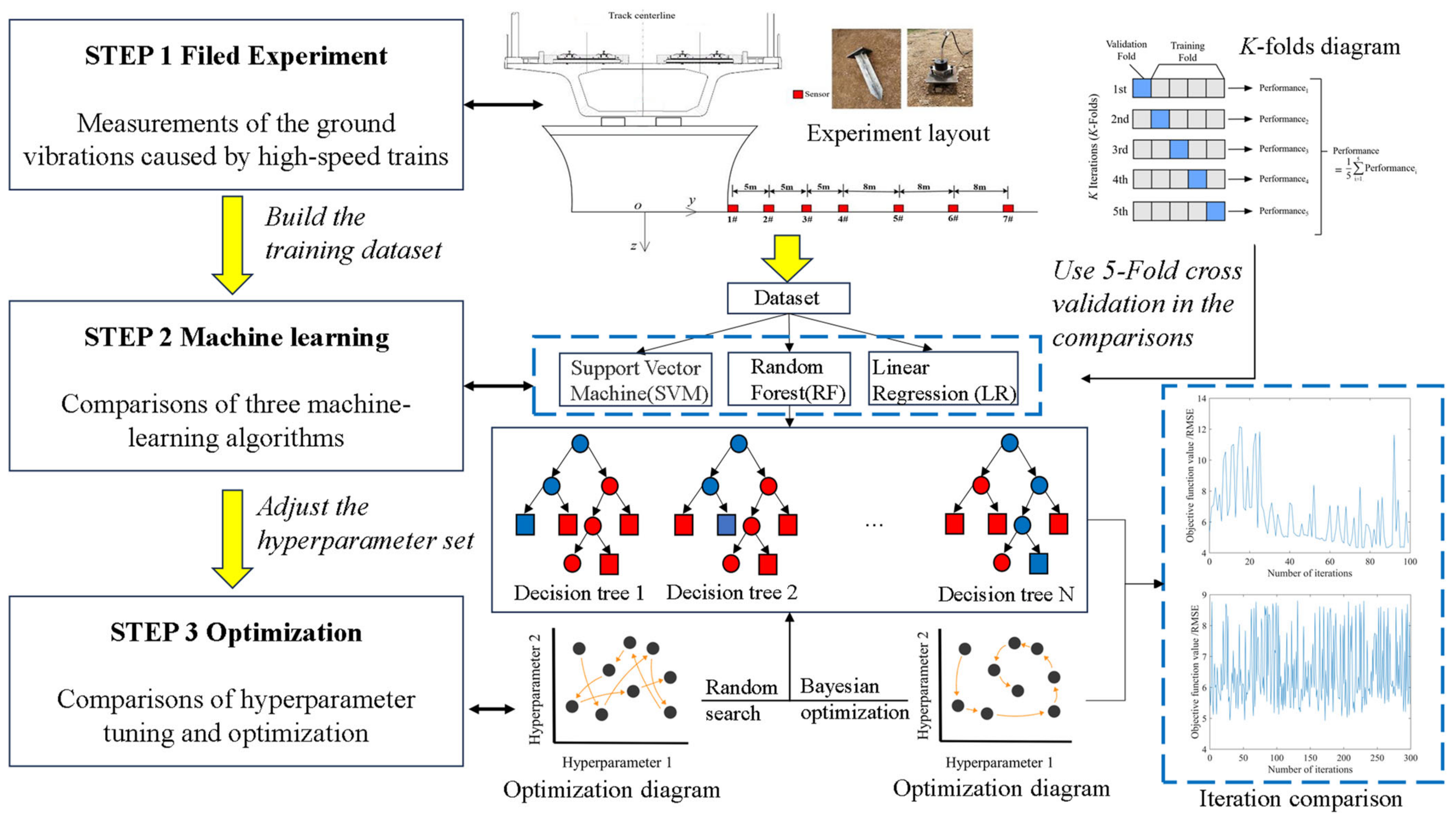


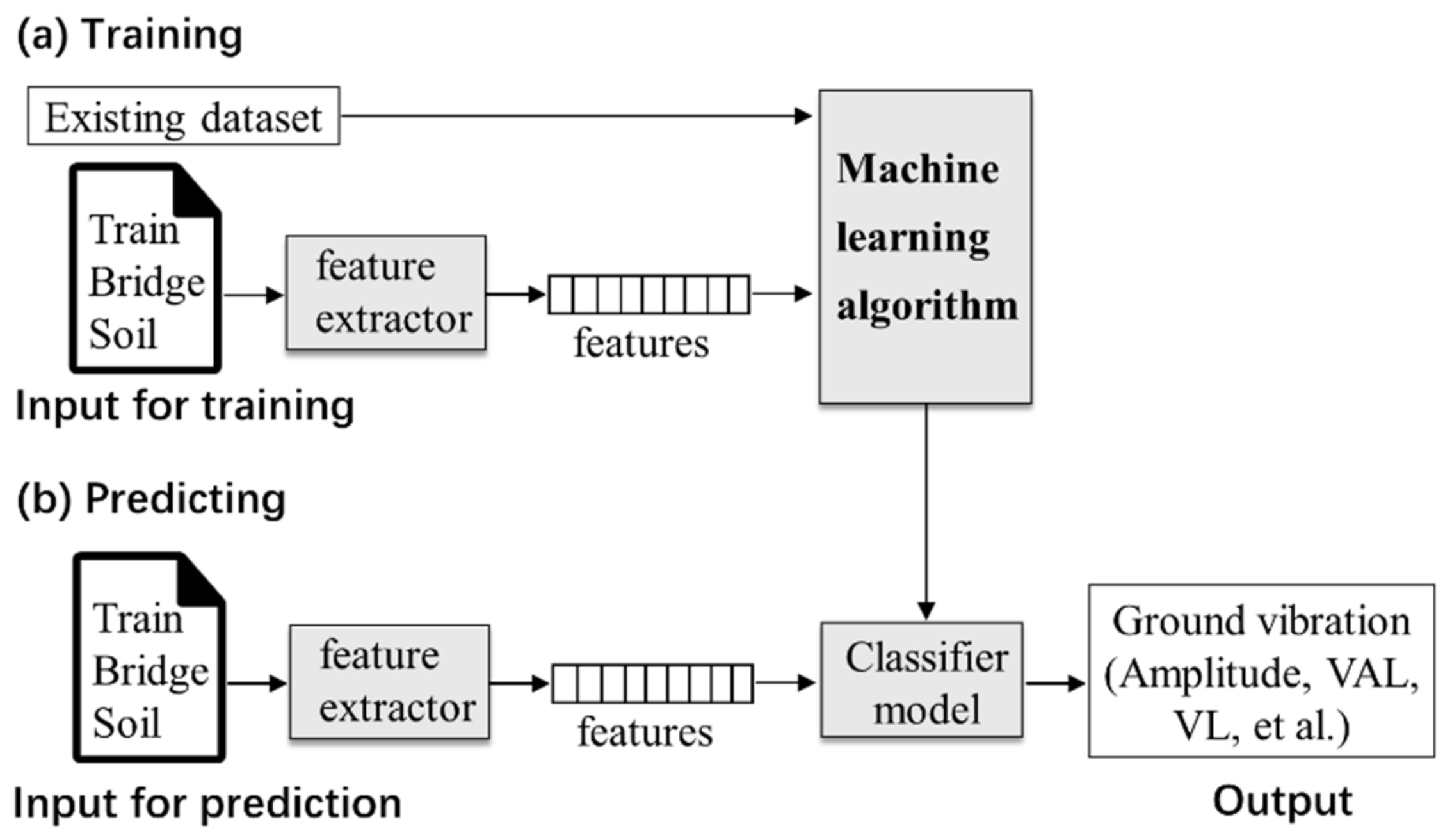

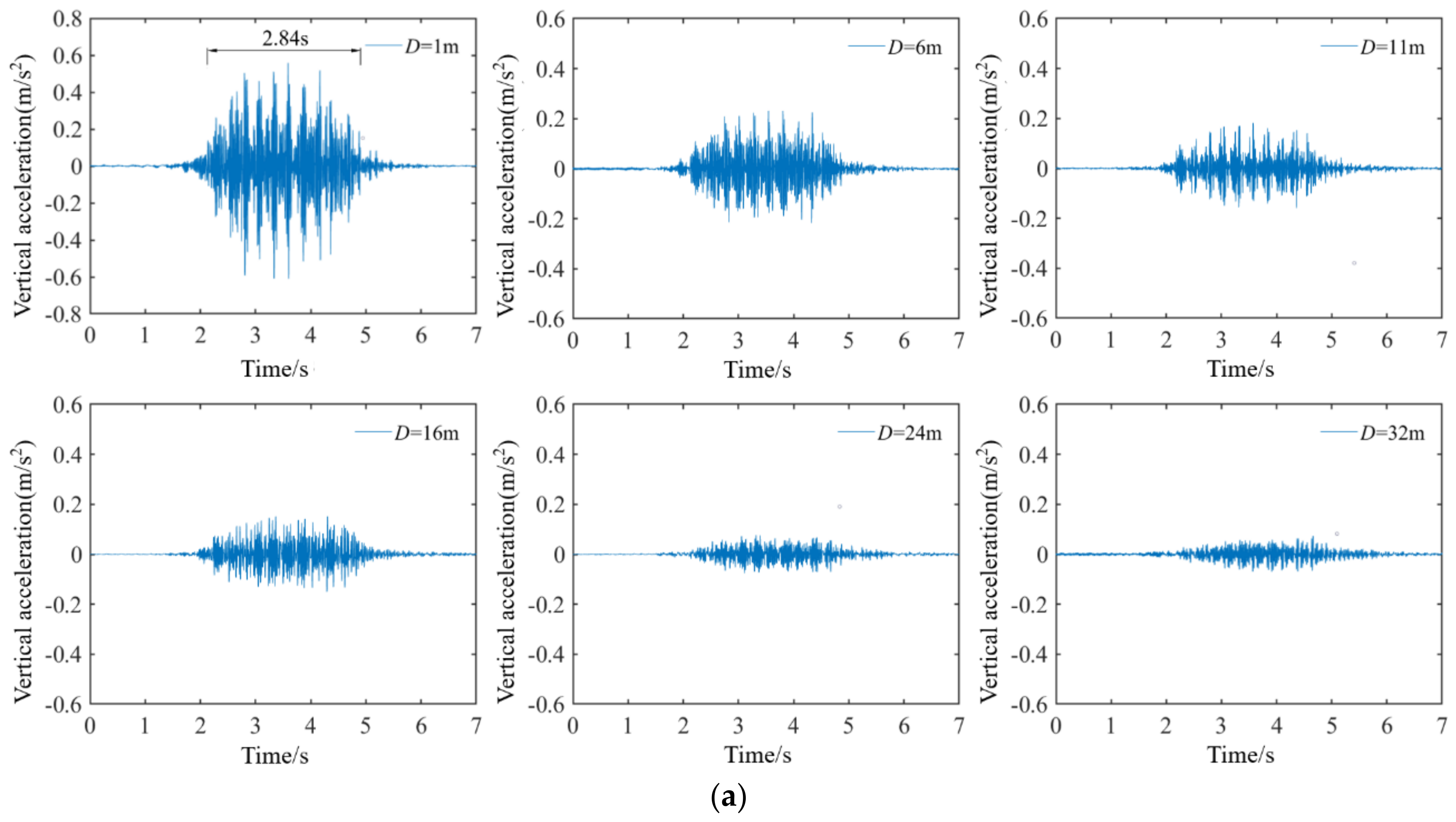



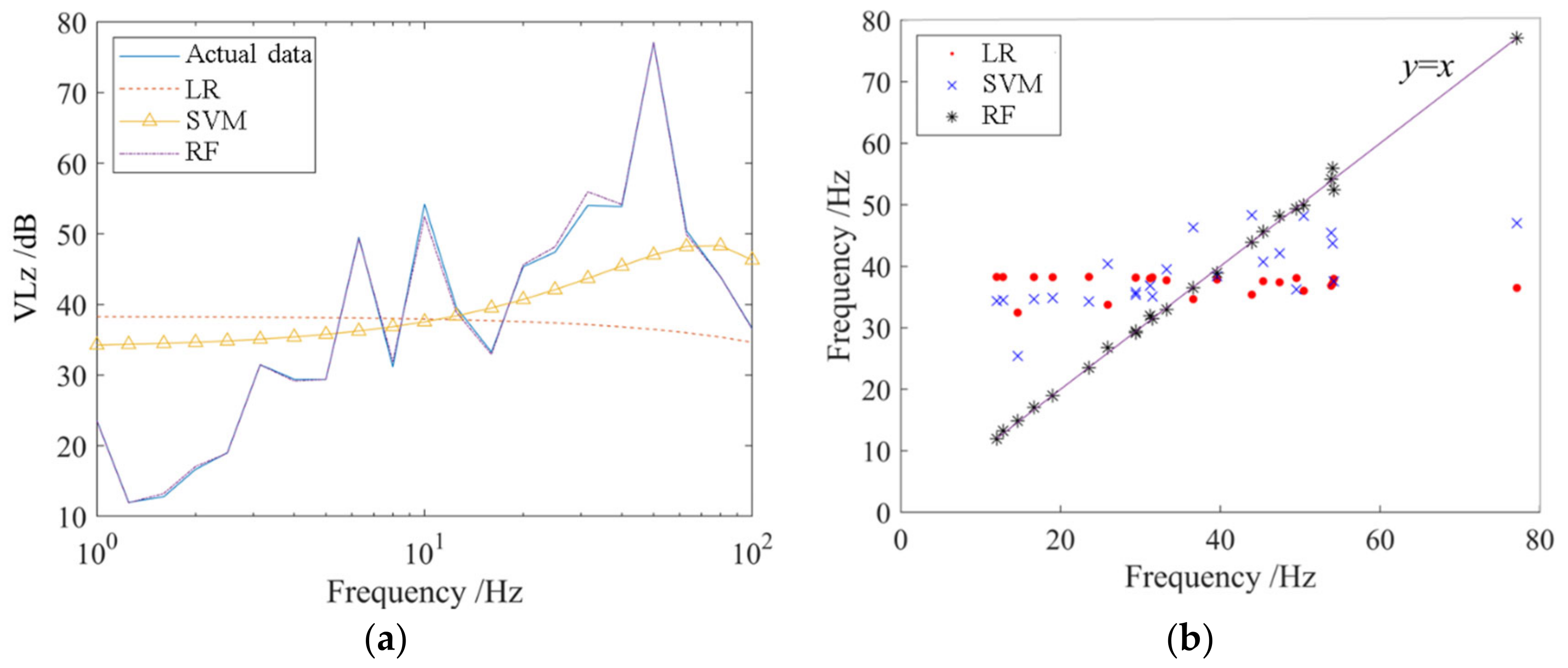

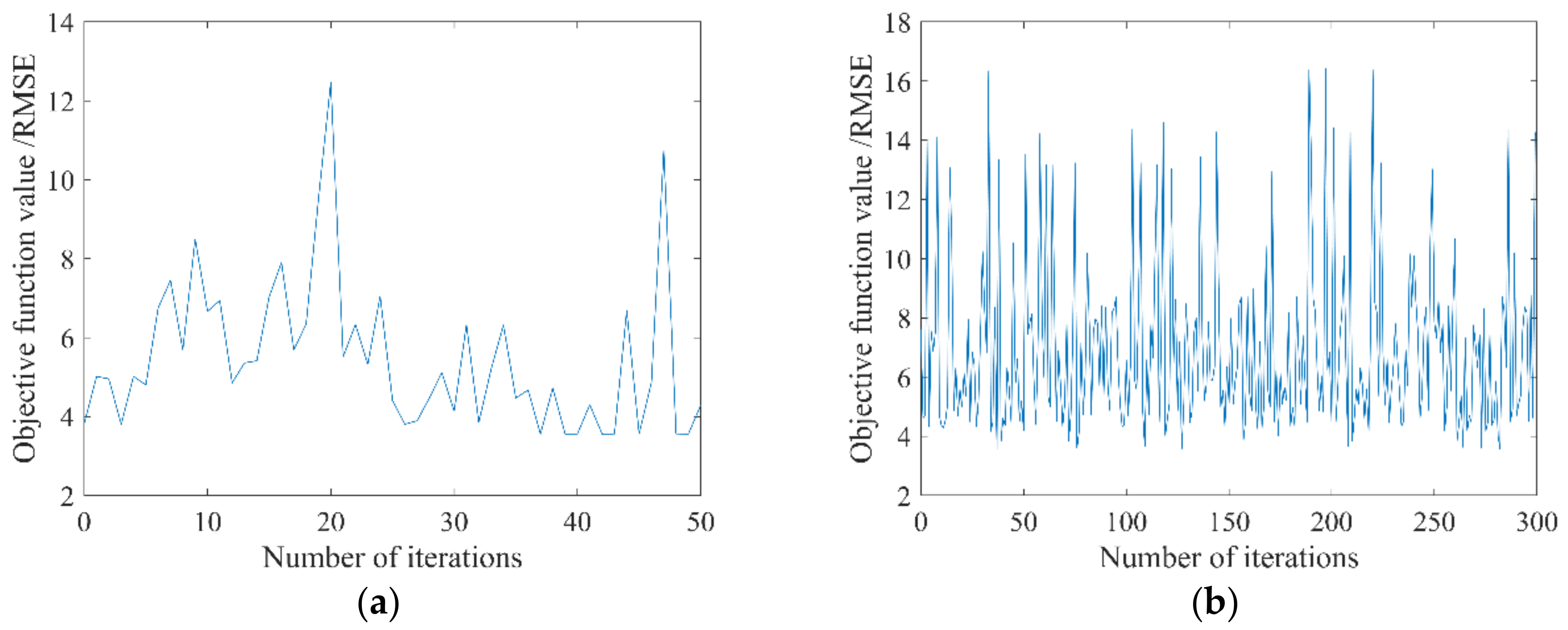
| Hyperparameter | Min | Max |
|---|---|---|
| n_estimators | 10 | 300 |
| max_depth | 2 | 40 |
| min_samples_split | 2 | 25 |
| max_features | 1 | 4 |
| Model | MSE | RMSE | MAE | R2 |
|---|---|---|---|---|
| LR | 373.60 | 19.33 | 16.19 | 0.066 |
| SVM-linear | 381.60 | 19.53 | 16.16 | 0.046 |
| SVM-polynomial | 212.64 | 14.58 | 12.17 | 0.468 |
| SVM-gaussian radial | 239.57 | 15.48 | 12.93 | 0.401 |
| Decision tree | 129.99 | 11.40 | 9.06 | 0.675 |
| RF | 11.07 | 3.33 | 2.36 | 0.972 |
Disclaimer/Publisher’s Note: The statements, opinions and data contained in all publications are solely those of the individual author(s) and contributor(s) and not of MDPI and/or the editor(s). MDPI and/or the editor(s) disclaim responsibility for any injury to people or property resulting from any ideas, methods, instructions or products referred to in the content. |
© 2023 by the authors. Licensee MDPI, Basel, Switzerland. This article is an open access article distributed under the terms and conditions of the Creative Commons Attribution (CC BY) license (https://creativecommons.org/licenses/by/4.0/).
Share and Cite
Cao, Y.; Li, B.; Xiang, Q.; Zhang, Y. Experimental Analysis and Machine Learning of Ground Vibrations Caused by an Elevated High-Speed Railway Based on Random Forest and Bayesian Optimization. Sustainability 2023, 15, 12772. https://doi.org/10.3390/su151712772
Cao Y, Li B, Xiang Q, Zhang Y. Experimental Analysis and Machine Learning of Ground Vibrations Caused by an Elevated High-Speed Railway Based on Random Forest and Bayesian Optimization. Sustainability. 2023; 15(17):12772. https://doi.org/10.3390/su151712772
Chicago/Turabian StyleCao, Yanmei, Boyang Li, Qi Xiang, and Yuxian Zhang. 2023. "Experimental Analysis and Machine Learning of Ground Vibrations Caused by an Elevated High-Speed Railway Based on Random Forest and Bayesian Optimization" Sustainability 15, no. 17: 12772. https://doi.org/10.3390/su151712772





